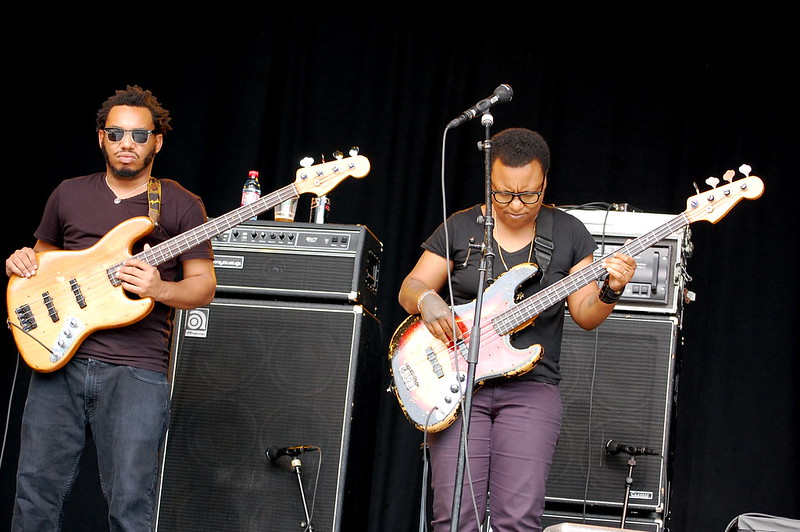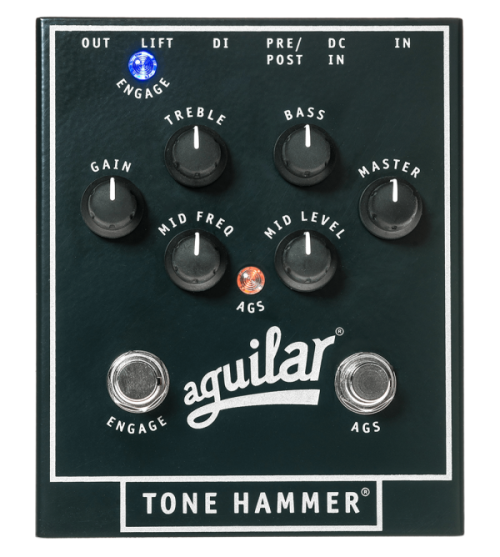Preamps primarily serve two purposes: shaping your tone, and boosting the signal from your bass guitar before it hits your power amp. Without using a preamp, your bass can sound thin and flat.
A bass preamp unit is useful for achieving a specific tone or gain structure before the signal reaches the amp or audio interface. It allows you to carry your perfect tone with you on stage and deliver it to both the PA and backline. A preamp can greatly supplement or even replace your amp.
Preamps come in different forms. Bass amps and amp heads all include a preamp. Preamp pedals can be used to boost frequencies and shape your tone. Active basses have a built-in preamp. A sound card can act as a preamp. There are also rackmount preamps with adjustable EQs.
Using a bass preamp allows you to carry your sound with you everywhere, instantly switch between different tones, easily plug and play your tone into unfamiliar audio systems at live venues, augment an otherwise limited bass amp, or even emulate certain great-sounding amps.
Table of Contents
Use a bass preamp for shaping your public sound

In a live setting, it can be difficult for a bass player to have any control over their tone. Many venues will have a house amp, so you won’t be able to use your preferred amp tone.
Even if you do use your own amp, the sound engineer won’t always mic your bass amp or use the bass head input. Instead, they’ll often use a DI box before the amp head and split the signal, sending it to both the PA and your amp.
This means your amp isn’t in the signal chain leading to the PA. You end up with no control over your tone, having to rely on a sound engineer who might not know the tone you’re looking for.
Using a bass preamp pedal means you can take your custom tone and have it ready for every gig. This way, the colored signal is sent to the sound engineer from the very beginning and doesn’t get lost along the way.
It’s quite common in a live situation to use a preamp as the DI that goes straight into the house board. You can send the signal straight from your bass preamp to the PA, boosting the signal and producing a massive frequency range – bigger than any bass cab could ever produce.
You can then control the low end using a good bass cab on stage, something that adds a bright, crispness to your lows.
In smaller live venues, your amp and the PA system might blend together to create the overall sound. The bigger the venue, the less impact your amp has on overall sound, so the tone coming through the amp will be lost. That’s why a bass preamp is so important when adding color to your sound at a live venue.
A common setup is playing your bass into a preamp, then a compressor, then a DI box, into your power amp, and into your cab. You’ll be able to control the tone a lot better and you’ll hear exactly what you’re playing.
Use a preamp for easily dialing-in your tone for stage or recording
Preamps can give you some familiarity when you don’t know the equipment. If you’re playing on a stage and you’re not familiar with the backline, having a preamp that you know well can be really useful for quick tonal changes.
Pedal preamps give you a really quick way to shape tone. Lots of pedals have a ‘direct out’ that you can send to front of house in a live situation, or a mixing board or audio interface in the studio.
With a bass preamp, you can build your perfect tone and send it to the sound engineer through a DI box and to your amp through a jack. This makes your amp kind of a sound monitor, taking away the need to use it to adjust tone.
You can easily bypass the preamps on your amp by plugging your preamp pedal directly into your amp’s FX return loop. This will take your amp’s tone controls out of the signal chain, giving your preamp complete control over tone.
Use a preamp to avoid carrying a heavy bass amp
One of the worst parts of playing live is having to carry lots of heavy equipment. Instead of carrying a big heavy bass amp, which probably doesn’t have that many tone control options anyway, you can use a preamp pedal.
Again, the preamp can send your signal directly to the PA, acting as a tone boost if you’re using someone else’s amp. Having your own set tone in one pedal (or a pedal board) means you can play using any provided bass amp.
Having your settings good to go means you can make small EQ adjustments to suit your tastes, either to the one preamp pedal or, if you’re using several pedals, the one at the end of your pedalboard chain.
Amp pedals are increasingly sophisticated and may soon be capable of completely replacing an amp, simply by connecting a speakON connector to a cabinet.
Use a bass preamp for quick tone switching

When playing live, it’s important to be able to change your tone in an instant. An onboard preamp lets you flip between two tone options at the flick of a switch. For passive basses, however, a bass preamp or ab EQ pedal can be used for that second channel.
Use a bass preamp to emulate/replace a different amp
A good preamp can do a great job at emulating a certain amp. If you want to get the sound of a classic amp, but can’t afford to spend a lot, a preamp pedal can be a good alternative.
E.g. VT or BDDI preamps can emulate the mid/low thump of an Ampeg, the Tech 21 Blonde gets very close to that classic mellow Fender amp tone, the Tech 21 Leeds preamp pedal can reproduce a vintage Vox, a Rusty Box can mimic the all-round class of a Traynor amp.
As mentioned earlier, going straight from your preamp into an amp’s FX return slot bypasses the amp’s tone controls. So you can emulate a certain amp’s sound with your preamp and run it through another amp, turning a standard amp into something completely different.
Using a bass preamp for home recording and practice
A preamp comes in handy for practicing at home. You can run it directly into a headphone amp using an XLR cable. Connecting your computer or mp3 player into the headphone amp allows you to play along to music, without the need for a bass amp or audio interface.
When hooked up to your computer, preamps are also easy to record quick ideas – you can ‘plug and play’ quickly and easily, laying an idea down to record properly later on.
Other reasons for using a bass preamp
One of the frustrating things about active bass pickups is having to worry about changing the batteries. The batteries last a long time, but the tone tends to change as the battery goes down. Using a preamp that runs through a power supply can take away this hassle.
Pickups on some bass guitars have a very low output, which can lead to a weak, unbalanced sound. A preamp takes that low output and gives it a big boost before it reaches the amp, producing a more stable signal.
If your amp’s tone controls too basic, a bass preamp gives you a lot more control. A preamps is also a good way to overdrive the input of your head and improve your overall sound.
Why you might NOT need a bass preamp
If your amp has great built-in tone controls, e.g. a good gain section, overdrive and master volume, and/or a built-in DI, you might not need a preamp. Some amps have a great authentic tone that can’t be replicated through a preamp.
If you’re using a single type of bass guitar on stage, or if you have an idea of your perfect tone by combining the sound of your bass with a specific bass amp, a preamp may add no much value.
As mentioned, your bass amp already has a built-in preamp. If the amp is good, any other preamps in the signal chain are just add-ons for extra effects or EQ adjustments and might not be needed.
When recording, a preamp pedal is often not necessary. A passive bass can provide a good clean signal that the sound engineer will be able to shape into the desired tone.
For playing live, if you want to run your signal straight into a PA, a DI box might be more useful than a bass preamp. It can preserve the detail of your tone and send a cleaner signal to the PA.
Which bass preamp to choose?
Different preamps have different controls and circuits and tone shaping options e.g. built-in compressor, extra EQ bands, gain stage, etc.
Quality preamps are built to last. They’re really versatile pieces of equipment that can be used as a standard DI box, a drive pedal, or can be the focal point of your onstage sound. Not every preamp will deliver your perfect tone, but those with good EQ controls can give you more crunch and personality. This is especially helpful for basses with passive pickups.
The following are a few popular preamp pedals:
- Aguilar tone hammer.
- Delano MS-E Bass: a good preamp for minor tweaks on stage.
- Darkglass B7K pedal preamp: great for distortion and boosting high mids
- Darkglass Microtubes 900 Amp for shaping a main tone.
- Sansamp Tech 21 vt Bass
Pedal vs onboard (active) preamp vs rack mount
Some bass manufacturers produce pedals that pretty much do the same thing as their onboard (active bass) preamps. Aguilar’s OBP-3 on-board preamp is very similar to their Tone Hammer pedal, for example..
Since the 90s, rack mount preamps have gone down a lot in popularity. Still, if you want to keep things organized and like having lots of different features for high-power output, a rack mount can be a good option. They’re not very portable, however, so it depends on your usage.
***
Photo credits:
Featured image: courtesy of Darkglass Electronics
(2) “Bass player + Me’shell Ndegeocello” (CC BY-SA 2.0) by Patrik Hamberg
(3) Aguilar Tone Hammer – Aguilar

